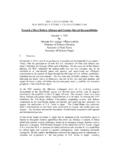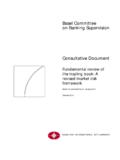Transcription of OCTOBER 2013 SUBURBAN SPRAWL - The Cost of …
1 REPORTOCTOBER 2013 SUBURBAN SPRAWL : EXPOSING HIDDEN COSTS, IDENTIFYING INNOVATIONSS ustainable CommunitiesBY: DAVID THOMPSON - CanStock Photo Inc /iofotoACKNOWLEDGEMENTSThe author thanks: Andrew Bevan for a warm and productive collaboration that led to the establishment of the Sustainable Communities program and the initiation of this report; anonymous interviewees from the property development industry, municipal government, academia and the non-profit sector for giving freely of their time and insights; Stephanie Cairns and Mike Wilson for many exchanges of ideas and for helping to steer this report through reviews; Dana Krechowicz, Brittany Richardson and Barbara Hayes for steering it through production; Allison Thompson for skilful research under tight timelines; Dana Krechowicz, Stephanie Cairns, Alexander Wood, Pamela Blais, Noel Keough, David Amborski, Alex Long and Michael Cleland for very helpful reviews of drafts; Karen Sherlock for careful and accurate copy-editing; Brittany Richardson for professional design and layout; Jack Dylan for the infographic design; and Jennifer Wesanko for the communications strategy for the report's release.
2 The author takes full responsibility for the David Thompson1 Sustainable Prosperity is a national research and policy network, based at the University of Ottawa. SP focuses on market-based approaches to build a stronger, greener, more competitive economy. It brings together business, policy and academic leaders to help inno vative ideas inform policy University of Ottawa, 555 King Edward Avenue, Ottawa, ON K1N 6N5 613-562-5800 x3342 SPRAWL : EXPOSING HIDDEN COSTS, IDENTIFYING INNOVATIONSEXECUTIVE SUMMARYFor thousands of years, cities and towns were built at a human scale. Even large cities were walkable. Then, within the span of two lifetimes, cities and towns were completely transformed. Instead of being built for people, they were being built for automobiles. They has a number of characteristics: low density of development per hectare; rigorously separated uses ( , long distances between housing and retail); leapfrogging past existing areas of build-up, leaving undeveloped gaps; and/or dependency on the automobile.
3 Most of all, SPRAWL is characterized by development on previously agricultural or natural greenfield , suburb-dominated municipalities are now common worldwide and predominant in North America. While 81% of Canadians now live in urban areas, half of metropolitan residents are in the suburbs, and suburbs are growing 160% faster than city centres. Although SPRAWL is common, it is still in the experimental stage, and we don t know how this experiment will work out. The signs suggest we will need to be more aware of the hidden costs and consider innovative ways to create denser urban have the suburbs grown so fast? Much of the literature places the blame on municipal plans and zoning rules. However, while such plans and rules allow for SPRAWL and even shape it, they don t require it. There is however a demand for SPRAWL ; people and firms have been choosing the suburbs without considering some of the other costs. Why is that?
4 A key factor is price: it s cheaper to buy a house in the suburbs. In a 2012 survey, 79% of Toronto-area residents said prices influenced their choice of location; the survey concluded that housing affordability, not personal preference, may be driving homebuyers to the suburbs. Likewise, for firms that have a choice of location, the suburbs are generally cheaper. Prices are lower in sprawling areas for a number of reasons. Distance from city amenities is one reason, but it is not the only one. Markets don t exist in a vacuum; they exist in a framework of government policy and law, and are heavily influenced by it. For example, several decades of government spending on major free-to-use highway systems has enabled daily long-distance commuting. Furthermore, the ongoing policy failure to address the other costs of road use (such as illness, injuries and climate change) subsidizes and perpetuates automobile use and suppresses the price of transportation to and from SUBURBAN EXECuTIVE SummArYMost significantly, undercharging developers for necessary infrastructure and municipal costs created by new greenfield developments artificially distorts the market in favour of sprawling development, though some municipalities are starting to examine the underlying costs.
5 Utility pricing that fails to reflect the higher costs of servicing sprawling areas is another hidden OF SPRAWLThe costs of SPRAWL are many and diverse. Some of these costs are counted, meaning they show up on financial statements. Other costs are hidden they don t show up on financial statements, but they are real and substantial. Different stakeholders pay for SPRAWL in different ways, either directly or indirectly. However, it is important to realize that we all businesses, governments, and homeowners-- bear the costs in the and their taxpayers absorb many of the costs of development directly and in future infrastructure liabilities. Municipalities can pay a significant financial cost for sprawling development. Sprawling SUBURBAN development requires new infrastructure and thus new capital spending. When a new development is approved on the fringes, municipalities get additional property tax revenues, but they also pick up new costs, including liability for future infrastructure maintenance and replacement costs that continue indefinitely, and rise over time.
6 In the inital wave of SPRAWL , these costs were not charges help municipalities recover some of these costs from developers but not all of them. Municipalities are beginning to understand the burden these costs place on their communities. In Edmonton, for instance, the City picks up all the capital costs of fire and police stations, and portions of some roads and recreation facilities. It also covers all the costs of maintenance, repair and renewal of the infrastructure, including pipes and roads. The costs to Edmonton of new SUBURBAN developments will exceed revenues by a very large margin. Across just 17 of more than 40 new planned developments, costs to the City are expected to exceed revenues by nearly $4 billion over the next 60 is not alone. Peel Region recently determined that new development was not paying for itself. Calgary Mayor Naheed Nenshi has started calling these hidden costs the " SPRAWL subsidy.
7 "Some muncipalities are starting to ask questions and find savings. In established areas, much or all of the required infrastructure already exists, and so redevelopment and infill development typically entail significantly lower municipal capital spending. Halifax Regional Municipality (HRM) recently found that it could save hundreds of millions of dollars by reducing the expansion of low-density sprawling development and opting for more dense urban development. Calgary found that by adopting a denser growth pattern that used 25% less land, it could save $11 billion in capital costs alone. Today's transportation systems further mask the costs of SPRAWL . The vast majority of roads in Canada are free to use, but they aren t cheap to build or maintain. Governments in Canada spend almost $29 billion on roads every year far more than they spend on transit, rail, air, marine and all other transportation modes combined.
8 Fuel taxes, licence fees and all other motor vehicle payments cover only a little over half of that cost; $13 billion is subsidized by other large subsidy to road use is overshadowed by other costs that don t appear on financial statements: air pollution, climate change emissions, noise, delay from traffic congestion, and losses and injury from collisions. Estimates of these costs range upwards of $27 billion per year. Parking is also often free or heavily subsidized. Based on US estimates, the cost in Canada is in the tens of billions of dollars per year. SUBURBAN households can end up driving about three times more than households close to the city centre, with consequent costs to household budgets and to the economy. Higher transportation costs for extra car ownership and fuel cancel out some of the household budget savings from lower home prices. By thinking about the long-term costs differently, consumers could reconsider the preceived benefits of SPRAWL .
9 For instance, eliminating one car from a Calgary household s bills an average savings of about $10,000 per year--would put up to 18 times as many homes within financial reach (depending on income level). Clearly, the real cost of a SUBURBAN house to individuals and families is much higher than its sticker price. To address this in the future, home buyers may start considering the costs of more than just the properity at the time of the social side, the unquestioning expansion of SPRAWL obscures statistics on more motor vehicle collisions, higher IIIEXECuTIVE SummArY change and smog emissions, and higher levels of obesity, diabetes, and other chronic illnesses that also impose significant costs on the economy. For example, in Toronto smog emissions from automobiles cost the economy $ billion per year and kill an estimated 440 people per year. From yet another angle, businesses pay the costs of SPRAWL every business day.
10 Roads congested by commuter traffic delay freight and raise delivery costs. Long-distance commuting, as well as the mental and physical health problems associated with SPRAWL , raise employee absenteeism while reducing , SPRAWL encroaches on natural areas surrounding municipalities, stressing and even eliminating key ecosystem services, such as water filtration, storage and runoff control, fresh air, erosion control, pollination, recreation and aesthetic enjoyment. The total value of such services provided by the Toronto greenbelt has been estimated at $ billion per year. INNOVATIONSM unicipalities from St. John s to Vancouver have identified goals for the reduction of future SPRAWL and the creation of more liveable communities. However, little progress has yet been made, and the majority of population growth still occurs in the suburbs. Fortunately, there are communities examining the costs and finding innovative options.






